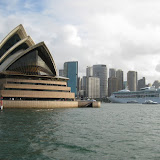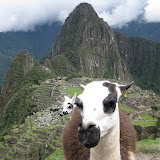
It's been far too long since I last wrote on here. I could easily write at least three separate entries on this last week alone, but I'm going to simply try to combine as much as I can into one behemoth of an update, even without the monkeys, birds, a visit to the biggest island in a lake in the world (two volcanos joined at the hip), border crossing into Costa Rica, etc. I'll even try to keep it concise... wish me luck.
Fun stuff first. Like the picture on the left. That's me, volcano boarding. I decided that climbing up an active volcano and roasting marshmallows was pretty good, but not quite enough. So I climbed Cerro Negro, the youngest volcano in Central America, and decided to go back down a little more quickly than I went up. Basically you take a snowboard, strap metal to the bottom, take it to the top, strap your feet on, and throw yourself off the side of a (steep) slope of volcanic sand and rock. Volcano Boarding. Of the group I hiked up with, I was the only one
dumb brave enough to take the fast way down (everyone else hiked it). At the end I asked if I could do it again, and they said no. Something about having to hike up the side of a slippery active volcano full of black rock in the hot sun once being more than enough, I guess.
At the end of the week, I took the boarding thing back to where it started: the waves. I had my first surfing lesson off the beach of San Juan del Sur. If you can believe it, surfing is even more fun than it looks. I can't even start to do justice to what catching your first wave feels like. I know nothing like that rush. No fear, just pure exhilaration while you stand on top of the ocean as it charges to shore. I got a little battered by the end from catching my board at odd angles in the waves, but that was probably the most fun I've ever had at a beach. The only irritating thing was afterwards when I accidentally got board wax on my shirt. Turns out this white wax doesn't come off with soap and water. It comes off like magic when you use and iron and wax paper, which is great, if you happen to be in a country where they sell wax paper. As far as I can tell, that's not going to be until Australia for me.
Board sports aside, it's been an interesting week. I mentioned at the end of my last post that the head of a nonprofit wanted to show me a metaphor for the country. It turned out to be at the top of a hill near Leon. A dirt road led up the hill to a small fortress built by the US-backed president
Somoza. Set against a gorgeous view of the surrounding mountains and the Pacific Ocean, lay what amounted to a prison where the national guard tortured and killed Sandinista rebels. There were broken water pipes and electrical wires still sticking out from the walls, near an octoganal interrogation room (built to maximize echoes). Gun turrets on top pointed toward the city in case the population ever got "uppitty." There was a solitary confinement chamber, too small to sit in, and too low to stand in. All used to suppress opposition until the Sandinista's successfully defeated the occupying army in the 80s.
The Sandinistas are now a political party, the FSLN, instead of the revolutionary army. The opposition party, the PLC, was in power in Leon not too long ago. They looked at this site of history and violence, set against a spectacular backdrop, and instead of making it a monument like the kind I saw in El Salvador, or even putting some kind of marker to honor or acknowledge the dead buried just outside the fortress walls, they turned it into a dump. Literally. Right next to the fortress stands one of the largest, steamiest, smelliest municipal garbage dumps I've ever seen.
Some hope the FSLN might change that kind of thing, but it's not an easy thing to do. I came into Nicaragua on their election day. It was just local elections, and the FSLN cleaned house. I actually almost walked right into a bunch of them with bandanas covering their faces, waving flags and stopping traffic in Managua to celebrate. I'm still not certain if they were carrying and firing firecrackers or guns-- having heard two people had died in a fight over the election a day before, I decided being an obvious foreigner in that place might not be a good idea. But, as I traveled, read headlines, saw news and talked to people. I heard news of fights in the streets. Questions of legitimacy began to leak out. Either the PLC was trying to discredit their loss, the FSLN actually pulled some strings, or both. Mostly though, it just reminded me of our own elections, back in 2000 and 2004, when we had a few questions about legitimacy ourselves. As one Nico summed it up, "No me sopresa. 200 años, la misma mierda." ('Doesn't surprise me. 200 years, the same sh*t.´) In the US, when elections were shadowed by chads and screwy voting machine access and screwy voting machines themselves, some people got mad. Others became complacent. The results will be up to others to judge.
Though judge they certainly have. It was a bit of a black eye whenever we as a country would go somewhere promoting democratic leadership, and whoever we talked to would come back and point out that our president wasn't democratically elected but
appointed by the supreme court. It's an attitude that filtered its way down to how Americans are treated by everyone else, including of course, travelers like me. Most people of other nationalities I met were wise enough not to hold me accountable for my government's actions. But every once in a while, the questions would filter through and people would take me to task for the torture of prisoners, the imprisonment of people without trial or charge, the blatant defiance of things like 182-4 votes on the floor of the UN general assembly against our actions abroad. Some of the nicer would ones would pipe up and say that, actually most of the Americans they had met had been nice, intelligent, educated, and open-minded people, as if that was some sort of amazing surprise. Even those who said nothing would always have a brief "oh, you're one of them" look. I know many Americans who would pretend to be Canadian, just to avoid it all.
But about 13 days ago, that all started to change.
When Barack Obama was declared President Elect, I was sitting in a hotel bar in Suchitoto, El Salvador, watching with about six other American expats and travelers. Upon seeing us cheer, the Salvadoran bartender gave us all drinks on the house, and toasted a nation "that was once great, and will be great again."
Now everywhere I go, when I say "American", everyone everywhere says "Obama" back, and they are always smiling. Salvadorans, Hondurans, Nicos, and Ticos are all celebrating new leadership in the big neighbor to the north. Everybody from all over the world, local and traveler alike, is talking about it and the high hopes they have. I even had one Honduran man telling me all about how Obama was going to end all war.
The least optimistic thing I've heard is from a German girl who wondered whether he was going to make as big a change as everyone thought. She then followed that by saying "correct me if I'm wrong, but the Democratic party is controlled by the Jews, right?"(Yikes.)
But that aside, I'm for the first time finding that calling myself an American is opening doors instead of closing them. To answer the questions of whether Obama is really going to solve all our problems, no he won't. I'm sorry to say he won't end all war, and the economic crisis won't simply disappear. But that's missing the point. The real change is the new attitude we as a nation are bringing to the white house. That's what means more to me when I tell people where I'm from.
As I wrote in my personal journal 13 nights ago, ´for the first time since I started paying attention to politics in a real way as a teenager, I can be proud of my country's choice of leaders. I no longer have to feel embarrassed or make excuses for my government's actions and attitudes when I say where I come from. And, most importantly for me, for the first time, when someone asks me if I represent the majority of voting citizens in my country, I can look them in the eye and say "Yes, I do."
--
Check out this entry's Photos.
.jpg) As far as I'm concerned, it's not Christmas unless I get to play with kids. This year, it was a crowd, mostly orphans, from a local school here in Cuzco, Peru. We got Santa out to the courtyard to give them gifts, and then Peruvian Christmas fruitcake and homemade hot chocolate made with cinnamon, condensed milk, and cloves.
As far as I'm concerned, it's not Christmas unless I get to play with kids. This year, it was a crowd, mostly orphans, from a local school here in Cuzco, Peru. We got Santa out to the courtyard to give them gifts, and then Peruvian Christmas fruitcake and homemade hot chocolate made with cinnamon, condensed milk, and cloves.

.jpg)
.JPG)
.JPG)
 I am currently stranded on a Caribbean island.
I am currently stranded on a Caribbean island.

.JPG)
.JPG)
.JPG)
.JPG)

.JPG)







